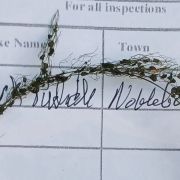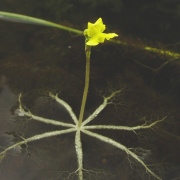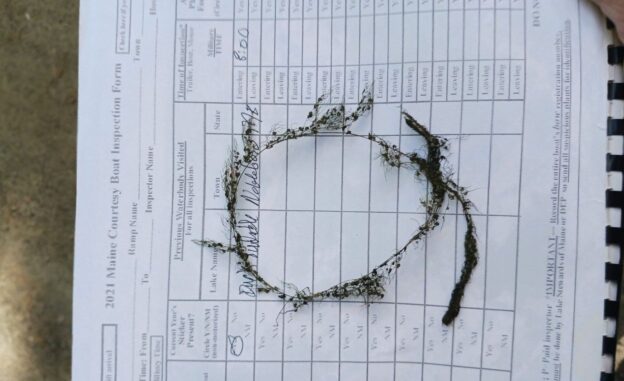 This is why we conduct Courtesy Boat Inspections! Dave Knight found this fragment of Common Bladderwort (Utricularia vulgaris) on a boat at the State Boat Launch last Saturday morning during his 2 hour shift (picture above and at left). The boat had previously been in Duckpuddle Pond in Nobleboro. There are no known invasive plants in DuckPuddle Pond (one of the questions we ask boaters is what body of water was their boat in last). This particular plant is a native, non-invasive aquatic plant and we already have it and another variety of Bladderwort in Clary Lake (Floating Bladderwort, Utricularia gibba), but there IS a variety of Bladderwort that we don’t have called “Swollen Bladderwort” which has only recently been designated as invasive. Swollen Bladderwort looks a lot like Floating Bladderwort. This particular plant fragment was mostly dried out but it might have lived and continued growing if put back in the water.
This is why we conduct Courtesy Boat Inspections! Dave Knight found this fragment of Common Bladderwort (Utricularia vulgaris) on a boat at the State Boat Launch last Saturday morning during his 2 hour shift (picture above and at left). The boat had previously been in Duckpuddle Pond in Nobleboro. There are no known invasive plants in DuckPuddle Pond (one of the questions we ask boaters is what body of water was their boat in last). This particular plant is a native, non-invasive aquatic plant and we already have it and another variety of Bladderwort in Clary Lake (Floating Bladderwort, Utricularia gibba), but there IS a variety of Bladderwort that we don’t have called “Swollen Bladderwort” which has only recently been designated as invasive. Swollen Bladderwort looks a lot like Floating Bladderwort. This particular plant fragment was mostly dried out but it might have lived and continued growing if put back in the water.
This was a good outcome: had this been a fragment of an invasive plant that made its way into Clary Lake undetected, the outcome could have been lot different. Thanks Dave!!!
Here is a link to the Maine Department of Environmental Protection’s Invasive Aquatic Plant map showing which lakes in Maine are infested and with what:
While I’m at it, here’s Lake Stewards of Maine’s field guide to aquatic plants and their common native look-alikes:
A Little About Bladderworts
Bladderworts are pretty neat plants. For one thing, they’re carnivorous! The “bladders”, from which the common named is derived, capture small aquatic organisms. Hairs at the opening of the bladder serve as triggers, and when contacted, mechanically cause the bladder to snap open, drawing in water and organisms like a vacuum. The ingested organisms are then digested, providing sustenance for the plant. Bladderworts are free-floating (not attached to the bottom) and have pretty yellow flowers. Nine species of Bladderwort are found in Maine, and 4 of them have possible invasive plant look-alikes: Common bladderwort (Utricularia vulgaris), Floating bladderwort (Utricularia radiata), Large purple bladderwort (Utricularia purpurea), and Northern bladderwort, or flat-leaf bladderwort (Utricularia intermedia). I’m only aware of two of these in Clary Lake, the Common and Floating varieties. The Floating Bladderwort is absolutely my favorite aquatic plant. Here’s a picture of its flower. The snap-dragon like flower is supported on a short stem, kept afloat by a raft of 6-7 specialized inflated branches (picture at left). From the Maine Field Guide: “All four species are aquatic and occur in both the floating-leaved and submersed plant communities. They may be found free-floating at or below the water surface, or trailing along the bottom of lakes, ponds, slow-moving streams, and wetland pools. Most aquatic bladderworts are adapted to survival on dry land when stranded by low water levels. Unlike rooted aquatic plants, that draw their nutrients primarily from the sediments, bladderworts, lacking roots, draw nutrients directly from the water. Bladderworts are carnivorous, and supplement their nutrient intake by capturing small prey, such as zooplankton or small insects.“
and Floating varieties. The Floating Bladderwort is absolutely my favorite aquatic plant. Here’s a picture of its flower. The snap-dragon like flower is supported on a short stem, kept afloat by a raft of 6-7 specialized inflated branches (picture at left). From the Maine Field Guide: “All four species are aquatic and occur in both the floating-leaved and submersed plant communities. They may be found free-floating at or below the water surface, or trailing along the bottom of lakes, ponds, slow-moving streams, and wetland pools. Most aquatic bladderworts are adapted to survival on dry land when stranded by low water levels. Unlike rooted aquatic plants, that draw their nutrients primarily from the sediments, bladderworts, lacking roots, draw nutrients directly from the water. Bladderworts are carnivorous, and supplement their nutrient intake by capturing small prey, such as zooplankton or small insects.“
If you’re interested in participating in our Courtesy Boat Inspection Program, contact George Fergusson or use our Contact Form. We can always use more volunteers!



Yes, we could use several more inspectors.
We will hook you up with the basic on-line tutorial that you can do at home. Then, we’ll be happy to schedule you to spend at least one 2 hour shift with an experienced inspector or until you are comfortable with the process. One or more of us are always available if you have questions or need help.
Required gear is a lawn chair, sunglasses and coffee or soda!! :-)) And of course, your I-phone.
Heck–we’ll even get you one of our really cool “COURTESY INSPECTOR” t-shirts.
Dave